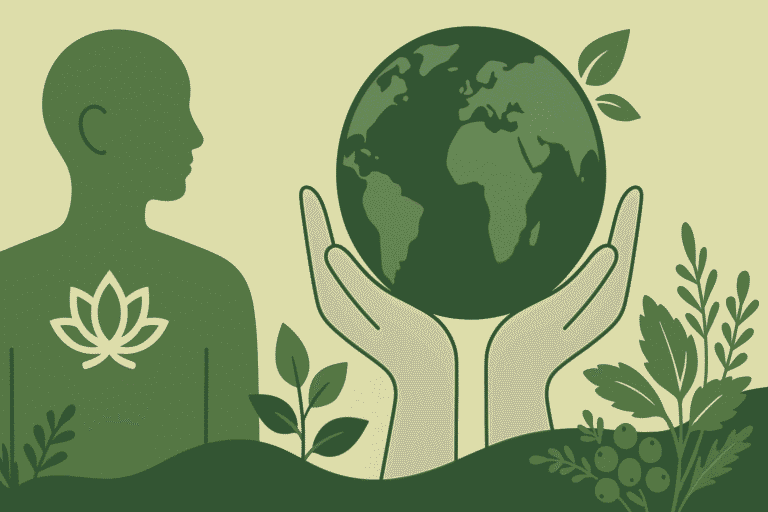contact@cayeit.com
In recent years, serotonin, often referred to as the “happiness chemical,” has gained widespread attention for its role in emotional and mental well-being. Modern neuroscience has shown that serotonin regulates mood, anxiety, and even sleep. But long before serotonin became a buzzword, Ayurveda, the ancient Indian system of medicine, had already identified the importance of emotional stability and mental clarity through the concept of Sattva.
While serotonin is the key neurotransmitter in modern science, Ayurveda’s approach to emotional wellness transcends chemicals. It focuses on balancing the mind through mental qualities (gunas) and energies (doshas). This blog dives into the journey from serotonin to sattva, exploring how modern science and Ayurveda intersect to promote emotional balance and well-being.
1. What is Serotonin, and Why Is It Important?
Serotonin is a neurotransmitter, a chemical that allows communication between brain cells. It plays a critical role in regulating mood, emotions, and even physical functions like digestion and sleep. Here’s a quick breakdown of its importance:
| Function | How Serotonin Plays a Role |
| Mood Regulation | Low serotonin is linked to depression and anxiety. |
| Emotional Stability | Helps maintain a sense of calm and emotional balance. |
| Sleep-Wake Cycle | Regulates melatonin production, impacting sleep quality. |
| Gut Health | Over 90% of serotonin is found in the gut, affecting digestion. |
For example, if you’ve ever felt a wave of happiness after eating chocolate or exercising, you’ve experienced a serotonin boost. However, when serotonin levels are low due to chronic stress or poor lifestyle choices, symptoms like irritability, sadness, or fatigue can arise.
2. Sattva: The Ayurvedic Concept of Mental Clarity
In Ayurveda, Sattva is one of the three gunas (mental qualities) that govern the mind. While serotonin is a chemical, sattva is a state of being—associated with purity, harmony, and mental clarity. The other two gunas are:
- Rajas: Represents activity, energy, and restlessness.
- Tamas: Represents inertia, ignorance, and dullness.
A sattvic mind is calm, compassionate, and emotionally stable—qualities that align closely with the effects of balanced serotonin levels. However, sattva is not something you “have” or “don’t have.” It is cultivated through diet, lifestyle, and habits.
| Quality | Sattva | Rajas | Tamas |
| Emotion | Peace, joy, contentment | Anxiety, anger, ambition | Depression, lethargy |
| Behaviour | Mindful, calm, balanced | Impulsive, restless | Withdrawn, stagnant |
| Goal | Mental clarity and purity | Drive and action | Rest and reflection |
3. Serotonin vs. Sattva: A Modern-Ayurvedic Perspective
Both serotonin and sattva play a role in emotional well-being, but their approaches differ significantly.
| Aspect | Serotonin (Modern Science) | Sattva (Ayurveda) |
| Definition | A neurotransmitter that regulates mood and emotions. | A mental quality symbolizing clarity, purity, and peace. |
| Source | Brain and gut chemistry, influenced by external factors. | Cultivated through lifestyle, food, and mindfulness. |
| Focus | Treats symptoms like depression or anxiety chemically. | Addresses the root cause holistically. |
| Enhancement Methods | Medications, exercise, and diet. | Sattvic diet, meditation, and dosha balance. |
While serotonin provides a biochemical explanation for mood regulation, sattva offers a lifestyle-based roadmap to achieve emotional harmony.
4. Cultivating Sattva: The Ayurvedic Path to Emotional Balance
To transition from relying solely on serotonin to embodying sattva, Ayurveda recommends cultivating a sattvic lifestyle. Here’s how:
1. Sattvic Diet
Your food is your medicine. A sattvic diet nourishes both the body and mind, promoting emotional stability.
- Foods to Include: Fresh fruits, vegetables, whole grains, nuts, seeds, and dairy (if tolerated).
- Foods to Avoid: Processed foods, alcohol, caffeine, and overly spicy or oily dishes.
For example, eating a simple bowl of khichdi (a mix of rice, lentils, and mild spices) can have a calming effect on both the mind and body.
2. Meditation and Mindfulness
Meditation is one of the most effective ways to enhance sattva. It helps regulate the mind, much like serotonin stabilizes mood.
- Practices like Sattvic Meditation or Nadi Shodhana Pranayama (alternate nostril breathing) can calm mental fluctuations and promote clarity.
3. Yoga and Physical Movement
Yoga is the bridge between the mind and body in Ayurveda. Poses like Balasana (Child’s Pose) and Shavasana (Corpse Pose) activate the parasympathetic nervous system, which is linked to serotonin production and helps cultivate a sattvic state.
4. Self-Care Rituals
Practices like Abhyanga (oil massage) and aromatherapy with essential oils like sandalwood or lavender nourish ojas, the essence of vitality, which in turn promotes sattva.
5. Modern Science Meets Ayurveda: Enhancing Serotonin and Sattva Together
The beauty of modern science and Ayurveda is that they can complement each other beautifully. Here’s how you can incorporate both approaches:
1. Exercise for Serotonin and Sattva
- Regular physical activity boosts serotonin levels and promotes sattvic energy.
- Activities like walking in nature double as a sattvic practice and a serotonin enhancer.
2. Gut Health and Emotional Health
- Serotonin is largely produced in the gut. Ayurveda’s focus on digestive health through herbs like Triphala and spices like ginger and cumin aligns with modern science’s emphasis on gut-brain connection.
3. Herbal Support
- Ashwagandha: Reduces stress and balances serotonin.
- Brahmi: Enhances mental clarity and sattva.
- Shankhpushpi: Calms the mind and improves focus.





